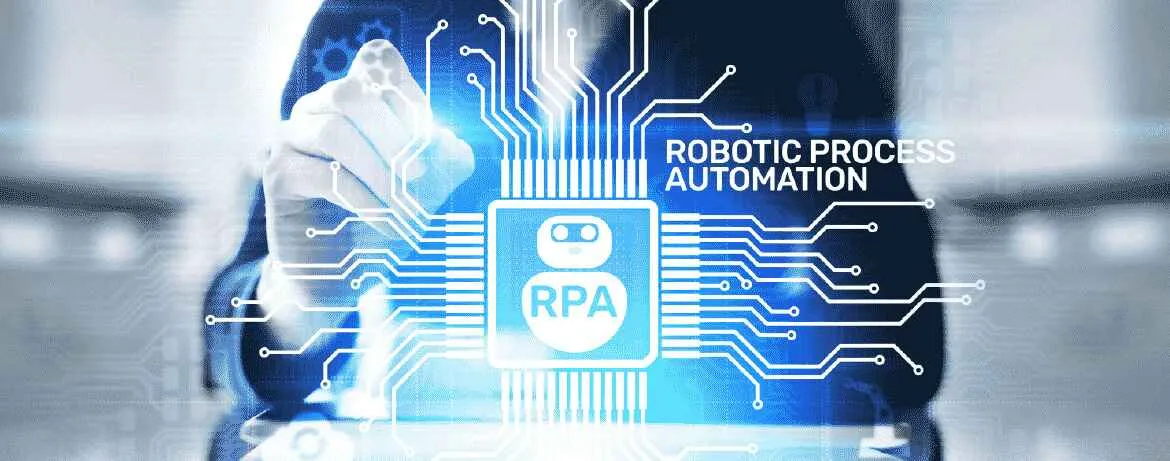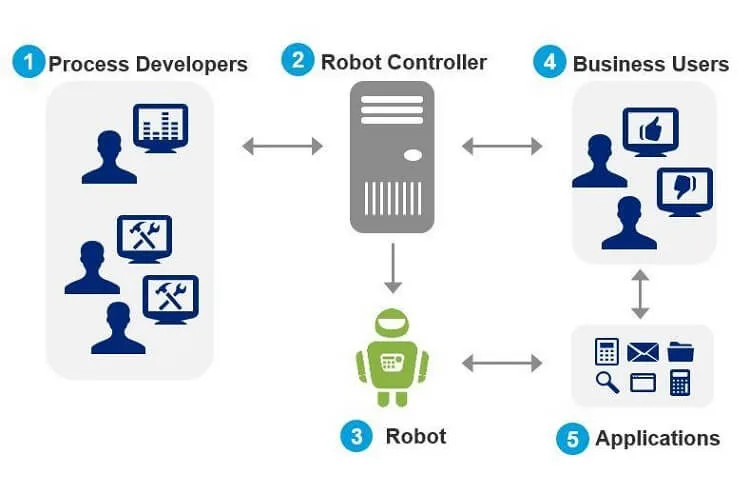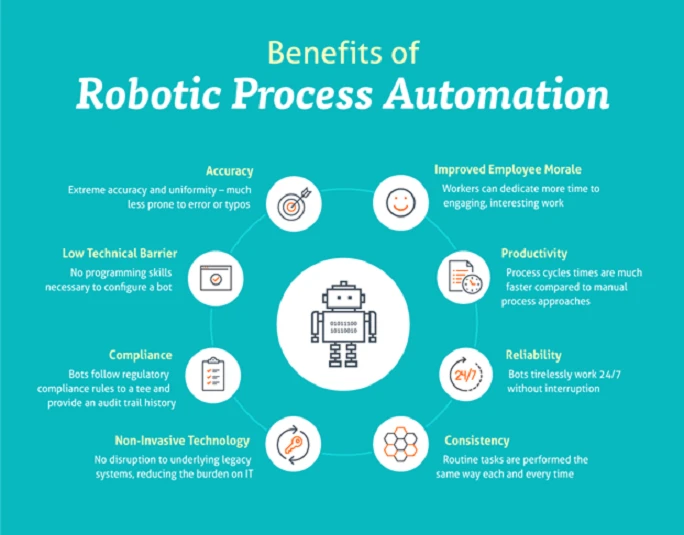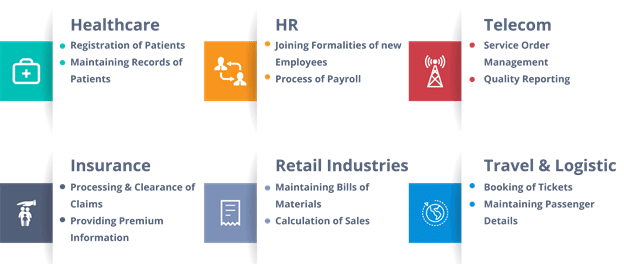
Robotic Process Automation (RPA)
If machine learning sounds like the beginning of a bleak dystopian future – think The Terminator mixed with The Matrix – then RPA must be the phase when the machines rise to rule humankind with ruthless efficiency.
First things first: There aren’t any robots involved in robotic process automation.
Fortunately, robotic process automation (RPA) involves nothing of the sort, except perhaps for the efficiency part. There aren’t even any robots involved in this automation software.
“Robotic process automation is not a physical or mechanical robot,” says Chris Huff, chief strategy officer at Kofax.
What is Robotic Process Automation?
RPA is an application of technology, governed by business logic and structured inputs, aimed at automating business processes. Using RPA tools, a company can configure software, or a “robot,” to capture and interpret applications for processing a transaction, manipulating data, triggering responses, and communicating with other digital systems. RPA scenarios range from something as simple as generating an automatic response to an email to deploying thousands of bots, each programmed to automate jobs in an ERP system.
COOs working for financial services firms were at the vanguard of RPA adoption, figuring out ways to use software to facilitate business processes without increasing headcount or costs, says Regina Viadro, vice president at EPAM Systems and adviser of the company’s IA practice.
Understanding How Robotic Process Automation (RPA) Works
RPA mirrors the way people are accustomed to interacting with and thinking about software applications. RPA's ability to copy the way humans perform a computer-based process has contributed to its popularity compared with automation tools such as application programming interfaces (APIs) or low-code development that are more scalable but less intuitive or require expert knowledge to use.
The simplest RPA bots can be created by recording the clicks and keystrokes as a user interacts with an app. When problems emerge, a user can simply watch how the bot is connecting with the app and identify the steps that need to be fine-tuned.
In practice, these basic recordings often serve as a template for building more robust bots that can adapt to changes in screen size, layout, or workflows. More sophisticated RPA tools use machine vision to interpret the icons and layout on the screen and adjust accordingly.
Some RPA tools are also able to use these initial recordings to create hybrid RPA bots that start by simply recording an existing workflow and then dynamically generating workflow automation on the back end. These kinds of hybrid bots take advantage of the simplicity of RPA development and the scalability of native workflow automation.

In other RPA implementations, process mining and task mining tools are used to automatically capture business process workflows that serve as starting templates for RPA automation. The process mining can analyze the logs of ERP and CRM applications, for example, to automatically generate a map of common enterprise processes. Task mining tools use a locally running app with machine vision to capture a user's interactions across multiple apps. All the major RPA vendors are starting to develop these kinds of process mining integrations.
RPA tools can also be connected to AI modules that have capabilities like OCR, machine vision, natural langue understanding, or decision engines, resulting in what is called intelligent process automation. These capabilities are sometimes packaged into cognitive automation modules designed to support best practices for a particular industry or business process.
Companies using RPA
Walmart, Deutsche Bank, AT&T, Vanguard, Ernst & Young, Walgreens, Anthem, and American Express Global Business Travel are among the many enterprises adopting RPA.
Walmart CIO Clay Johnson says the retail giant has deployed about 500 bots to automate anything from answering employee questions to retrieving useful information from audit documents. "A lot of those came from people who are tired of the work," Johnson says.
David Thompson, CIO of American Express Global Business Travel, uses RPA to automate the process for canceling an airline ticket and issuing refunds. Thompson is also looking to use RPA to facilitate automatic rebook recommendations in the event of an airport shutdown, and to automate certain expense management tasks.
"We've taken RPA and trained it on how employees do those tasks," says Thompson, who implemented a similar solution in his prior role as CIO at Western Union. "The list of things we could automate is getting longer and longer."
Benefits of RPA
As a user-friendly and cost-effective tool, robotic process automation provides several advantages that are drawing interest from organizations across industries.

The business benefits of RPA include:
- Low technical barriers: Programming skills are not necessary to configure a bot. Non-technical staff can use a process recorder feature to teach the bot how to perform a previously manual step in an automated business process and integrate the bot-based automation into a larger automated workflow using a drag-and-drop process designer or similar tool.
- Increased accuracy: Like many tools available as part of a process automation suite, bots are extremely accurate and consistent – they are much less prone to making mistakes or typos than a human worker. This can apply to common processes such as setting up or removing user accounts, copying information from one system to another, onboarding and off-boarding employees, or populating forms based on information from another system.
- Meet regulatory compliance standards: Bots only follow the instructions they have been configured to follow and provide an audit trail history for each step. The controlled nature of bots makes robotic process automation well suited for organizations that want to automate their business processes end-to-end while still meeting strict compliance standards
- No interruption of work: Bots can work tirelessly work around the clock, autonomously without requiring employees to re-activate them, allowing a more flexible schedule for business processes.
- Existing systems remain in place: Unlike traditional integrations that may require extensive developer resources, RPA doesn’t require any changes to the systems you already use every day to be included as part of your automated business processes. Bots work directly from a user interface, just as a person would. This makes robotic process automation especially useful for integrating legacy systems, where APIs may not be immediately available, or in situations where organizations do not have the time or employee resources to develop custom code-based integrations
- Improved employee morale and employee experience: By utilizing robotic process automation as part of their automation toolkit, organizations can open up further opportunities for employees to dedicate more of their time and talent to other work. While bots fill out forms, enter data, and lookup information from websites, employees can focus on high-impact projects that further drive growth.
- Increased productivity: Process cycle times are more efficient and can be completed at a faster speed compared to manual processes.
Applications of RPA
Some of the top applications of RPA include the following:
- Customer service: RPA helps companies provide better customer service by automating contact center tasks, including verifying e-signatures, uploading scanned documents, and verifying information for automatic approvals or rejections.
- Accounting: Organizations use RPA for general accounting, operational accounting, transactional reporting, and budgeting.
- Decision Tree: refers to a supervised learning method used primarily for classification. The algorithm classifies the various inputs according to a specific parameter. The most significant advantage of a decision tree is that it is easy to understand, and it clearly shows the reason for its classification.
- Financial services: Companies in the financial services industry use RPA for foreign exchange payments, automating account openings and closings, managing audit requests, and processing insurance claims.
- Healthcare: Medical organizations use RPA for handling patient records, claims, customer support, account management, billing, reporting, and analytics.
- Human resources: RPA can automate HR tasks, including onboarding and offboarding, updating employee information, and timesheet submission processes.
- Supply chain management: RPA can be used in supply chain management for procurement, automating order processing and payments, monitoring inventory levels, and tracking shipments.

Pitfalls of RPA
RPA isn’t for every enterprise. As with any automation technology, RPA has the potential to eliminate jobs, which presents CIOs with challenges managing talent. While enterprises embracing RPA are attempting to transition many workers to new jobs, Forrester Research estimates that RPA software will threaten the livelihood of 230 million or more knowledge workers or approximately 9 percent of the global workforce.
Installing thousands of bots has taken a lot longer and is more complex and costly than most organizations have hoped it would be, Edlich and Sohoni say. The platforms on which bots interact often change, and the necessary flexibility isn’t always configured into the bot. Moreover, a new regulation requiring minor changes to an application form could throw off months of work in the back office on a bot that’s nearing completion.
A recent Deloitte UK study came to a similar conclusion. "Only three percent of organizations have managed to scale RPA to a level of 50 or more robots," say Deloitte UK authors Justin Watson, David Wright, and Marina Gordeeva.
Moreover, the economic outcomes of RPA implementations are far from assured. While it may be possible to automate 30 percent of tasks for the majority of occupations, it doesn’t neatly translate into a 30 percent cost reduction, Edlich and Sohoni say.
What's next after RPA?
If you're here, you must be a big-picture thinker. The latest buzzword for where RPA technology evolves is hyper-automation. The idea is automating business processes—even automatically—of increasing complexity, that today rely on knowledge inputs from people. Automating begins to change the nature of work itself, not only by providing an accessible way for business processes to become more “digital” but by changing the human work experience and setting the stage for more complex and intelligent augmentation and transformation of business. In short, RPA defined the start of a new era of work.
Read more blogs here
